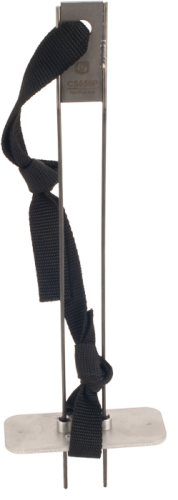
概要
CS650G を使用すると、土壌水分センサを密度が高い土壌や岩の多い土壌に簡単に挿入できます。このツールは、CS650G を使用しないとセンサを損傷する可能性のある力で土壌に打ち込むことができます。このツールは、センサのロッドを挿入するためのパイロット穴を開けます。このツールは、14383 と 14384 の両方に代わるものです。
イメージ



仕様
| 寸法 | 38.1 x 12.7 x 5.08 cm (15.0 x 5.0 x 2.0 in.) |
| 重量 | 204.12 g (0.45 g) |
動画とチュートリアル
よくある質問
CS650Gに関するよくある質問の数: 3
すべて展開すべて折りたたむ
-
土壌が岩だらけ、乾燥している、または硬い場合、Campbell Scientific は、センサを土壌に設置する前に CS650G を使用してパイロット穴を開けることを推奨しています。土壌に岩がなく、適度に湿っていて、比較的柔らかい場合は、通常、センサ ヘッドに穏やかで安定した圧力をかけることでセンサ ロッドを設置し、平行に保つことができます。
注意: ロッドを土壌に押し込むために、センサ ヘッドをハンマーで叩いたり、センサ ヘッドを踏んだりしないでください。
-
CS650 と CS655 は、ロッドが可能な限り互いに平行になるように土壌に挿入されると最もよく機能します。取り付け前に平行なパイロット穴を開けるには、CS650G ロッド挿入ガイド ツールを使用します。挿入中にロッドが小さな石や根に接触するなどしてロッドがわずかにたわんでも、測定値に大きな影響を与えない可能性がありますが、大きくたわむと、CS650 または CS655 が公表されている精度仕様の範囲外で動作する可能性があります。
-
土壌が岩だらけ、乾燥している、または硬い場合、Campbell Scientific は、センサを土壌に設置する前に CS650G を使用してパイロット穴を開けることを推奨しています。土壌に岩がなく、適度に湿っていて、比較的柔らかい場合は、通常、センサ ヘッドに穏やかで一定の圧力をかけることでセンサ ロッドを設置し、平行に保つことができます。
注意: ロッドを土壌に押し込むために、センサ ヘッドをハンマーで叩いたり、センサ ヘッドを踏んだりしないでください。
記事とプレスリリース
ニュースレター記事
以下に記載
Privacy Policy Update
We've updated our privacy policy. 詳細はこちら
Cookie Consent
Update your cookie preferences. クッキーの設定を更新する

